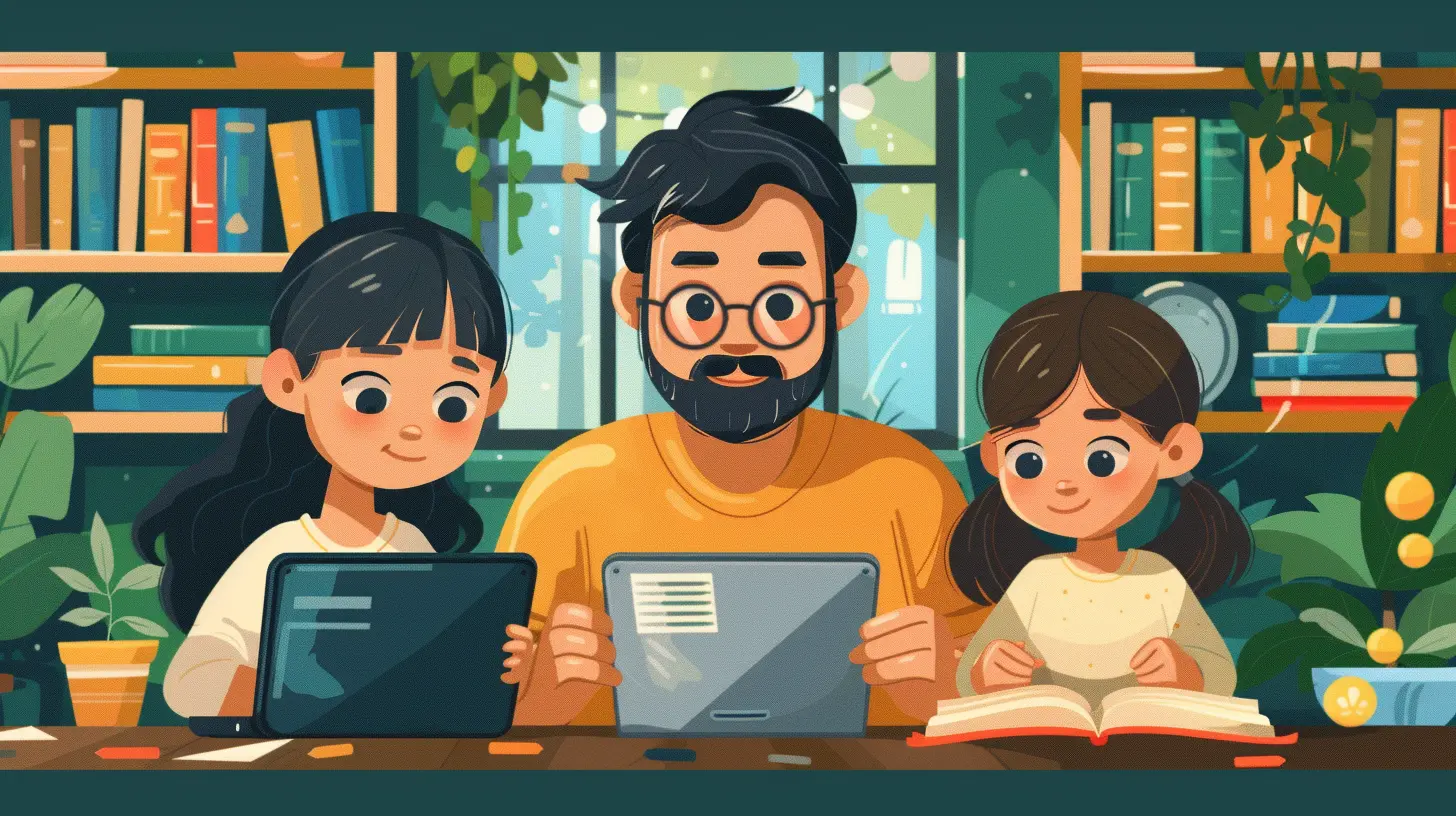How to Teach Your Kids to Be Responsible Digital Citizens
16 July 2025
Let’s face it—our kids are growing up in a world where tech is as natural to them as riding a bike was for us. From toddlerhood, they’re tapping, swiping, and watching with more confidence than many adults. So how do we, as parents, make sure our children are not just tech-savvy, but also responsible digital citizens?
It's not just about knowing how to use a tablet or set up a profile. It's about ethics, empathy, and common sense in an online world that doesn’t come with a manual. Scary? A little bit. But the good news—you don’t have to be a tech genius to guide your kids. You just have to be present, proactive, and a little bit patient.
What Does It Mean to Be a "Responsible Digital Citizen"?
Before we teach our kids about digital citizenship, we’ve got to understand what it means ourselves. A responsible digital citizen is someone who uses technology ethically, respectfully, and safely. That includes everything from protecting private information to treating others with kindness and thinking critically about what they read and share online.In other words—be the same good human online that you are offline.
Why Teaching Digital Citizenship Matters More Than Ever
The digital world is where our kids learn, connect, and play. Whether it's school assignments, gaming with friends, or scrolling through social media, the internet is woven into the fabric of their lives. But with great connectivity comes great responsibility. (Yes, we just semi-quoted Spider-Man.)Here’s what’s at stake if we don’t teach our kids to navigate this space responsibly:
- Cyberbullying: One mean post can damage someone’s self-esteem.
- Privacy Risks: Oversharing personal info can lead to identity theft or worse.
- Digital Footprint: What gets posted never truly disappears.
- Misinformation: The internet is not always right—shocking, we know.
Start With Conversations (Not Lectures)
Teaching starts with talking. The key? Keep it casual. Dinner table chats, car rides, bedtime talks—they're all golden opportunities.Here’s how you can start:
- “What do your friends post online?”
- “Have you ever seen something online that made you uncomfortable?”
- “Why do you think someone would pretend to be someone else online?”
These conversations help you understand your child’s online world and open the door to deeper discussions.
Set Clear, Realistic Boundaries
Just like you establish curfews and bedtimes, you need boundaries for digital use too. But remember, boundaries aren't about control—they’re about guidance.Here's what responsible digital rules might include:
- No devices at dinner
- Set screen-time limits by age
- Only use apps approved by parents
- Ask before downloading anything
- Avoid certain websites altogether
And hey, make these rules collaborative. Kids are more likely to follow guidelines they’ve had a hand in creating.
Be a Role Model Worth Copying
Let’s keep it real. If you’re scrolling through Facebook while telling your kids to limit screen time, you’re sending mixed signals. Kids are watching you more than listening to you—always.So practice what you preach:
- Be mindful of your own screen time
- Don’t post embarrassing photos of your kids without their okay
- Be respectful in your online interactions
Think of it this way: Your actions are the “settings” your child’s digital behavior defaults to.
Teach Online Kindness as Non-Negotiable
It’s easy to forget there’s a real person on the other side of that screen. That’s why empathy is essential online.Help your kids reflect before they react online. A simple rule to teach them: “If you wouldn’t say it face-to-face, don’t type it.”
Also, encourage your child to be an upstander, not a bystander. That means speaking up against online hate or reporting inappropriate behavior. Kindness is contagious—especially when it goes viral.
Help Them Understand Their Digital Footprint
Our kids might think Snapchat messages disappear forever—but that's just wishful thinking. Everything online leaves a trace. Yes, even those silly TikTok dances and Snapchat selfies.Teach your children that the internet remembers everything. One poor decision, like posting something offensive or inappropriate, could come back years later—like a bad haircut that never grows out.
Ask them:
- “Would you be okay with your teacher or grandma seeing this post?”
- “Will you be proud of this in five years?”
If the answer’s no, then maybe… just maybe… don’t post it.
Privacy Is Power: Teach Them to Guard Themselves
Would your child give their home address to a stranger? Probably not. But many kids unknowingly share personal info online all the time.Make sure your kids know:
- Never share full name, school name, address, or phone number
- Use strong passwords and avoid obvious choices like “1234” or “ilovepizza”
- Don’t talk to strangers online—even if they “seem nice”
- Turn off location on apps whenever possible
Protecting their privacy isn’t about paranoia—it’s about power and safety.
Talk About What’s Real and What’s Fake
The internet is a weird mix of brilliance and baloney. Help your kids build a “digital BS detector.”Teach them to:
- Check sources before believing or sharing
- Be critical of pictures and videos—many can be edited or staged
- Understand that followers or likes don’t equal truth
Also, chat with them about digital manipulation—like how influencers might be paid to promote a product or how advertisements are targeted.
Encourage a Healthy Tech-Life Balance
Let’s be honest—it’s super easy for all of us to get glued to screens. But too much screen time can mess with sleep, mood, and even self-esteem.Talk with your child about making time for:
- Outdoor play
- Reading books
- Face-to-face conversations
- Creative hobbies (drawing, music, building stuff)
You’re not banning tech—you’re just helping them use it in healthy amounts. Kind of like broccoli. Okay… maybe more fun than broccoli.
Teach Them What to Do When Things Go Wrong
Even with great guidance, mistakes and uncomfortable moments will happen. Your kid might get a nasty comment, click something they shouldn't, or accidentally post something private.Here’s how to prepare them:
- Let them know they can ALWAYS come to you without fear or shame
- Show them how to block/report offensive content or users
- Work through problems together instead of yelling or punishing
- Remind them that everyone makes mistakes—this is how we learn
When your child knows you're a safe space, they're far more likely to ask for help before things spiral.
Use Tech Tools to Your Advantage
Good news! There are actual tools that can help you guide your child online without hovering 24/7.Try using:
- Parental control apps (like Bark, Qustodio, or Norton Family)
- Built-in device settings to limit screen time or restrict content
- Monitoring features in apps like YouTube Kids
Think of these tools as training wheels—they help kids stay balanced until they’re ready to ride solo.
Keep the Conversation Going (Forever, Basically)
Digital citizenship isn’t a one-and-done talk. It’s an ongoing conversation, just like all the other life lessons—respect, empathy, honesty.So keep checking in. Ask about new apps they’re using. Watch videos together. Join them in their digital world so you understand it better. Kids evolve, and so does tech—so your guidance needs to grow with them.
Final Thoughts
Raising responsible digital citizens is a journey. It’s not about having all the answers or shielding kids from the online world, but rather giving them the tools and wisdom to navigate it with confidence, courage, and compassion.As long as you’re showing up, staying curious, and keeping communication open—you’re doing a great job. Really.
So the next time your child asks to download a new app, don’t panic. Take a deep breath, start a conversation, and guide them one scroll at a time.
You’ve got this.
all images in this post were generated using AI tools
Category:
Tech And KidsAuthor:

Noah Sawyer
Discussion
rate this article
2 comments
Blake Graham
Empower your kids to navigate the digital world with confidence. Teach them accountability, critical thinking, and respect online—because responsible digital citizens start at home. No excuses!
November 24, 2025 at 5:28 AM

Noah Sawyer
Absolutely! Teaching kids these values at home is essential for fostering responsible digital citizens. Empowerment through guidance is key!
Greta Wright
Are we ready for their digital shadows?
July 25, 2025 at 2:53 PM

Noah Sawyer
Yes, preparing kids for their digital shadows is essential. Education on responsible online behavior fosters awareness and accountability in their digital interactions.


